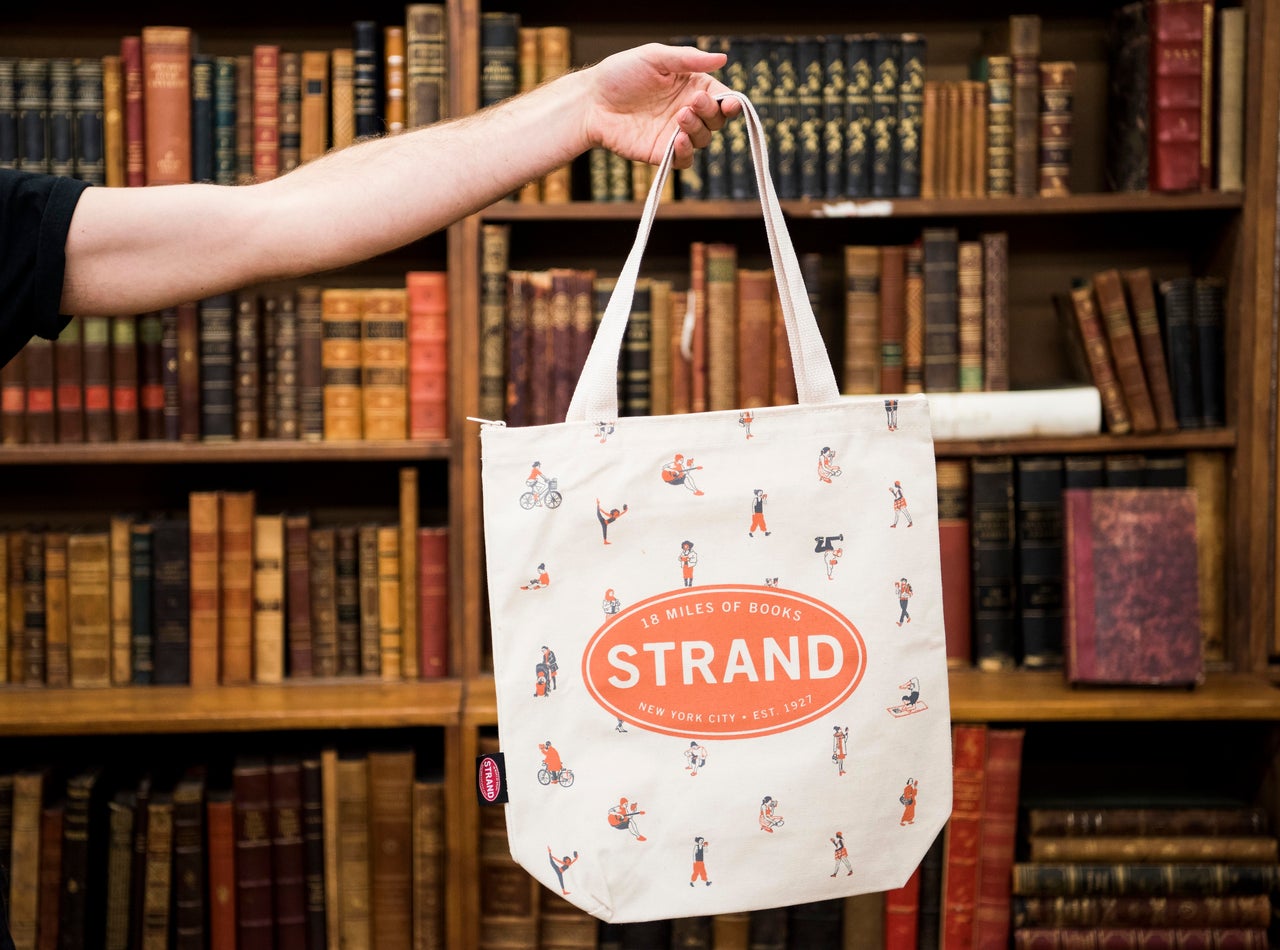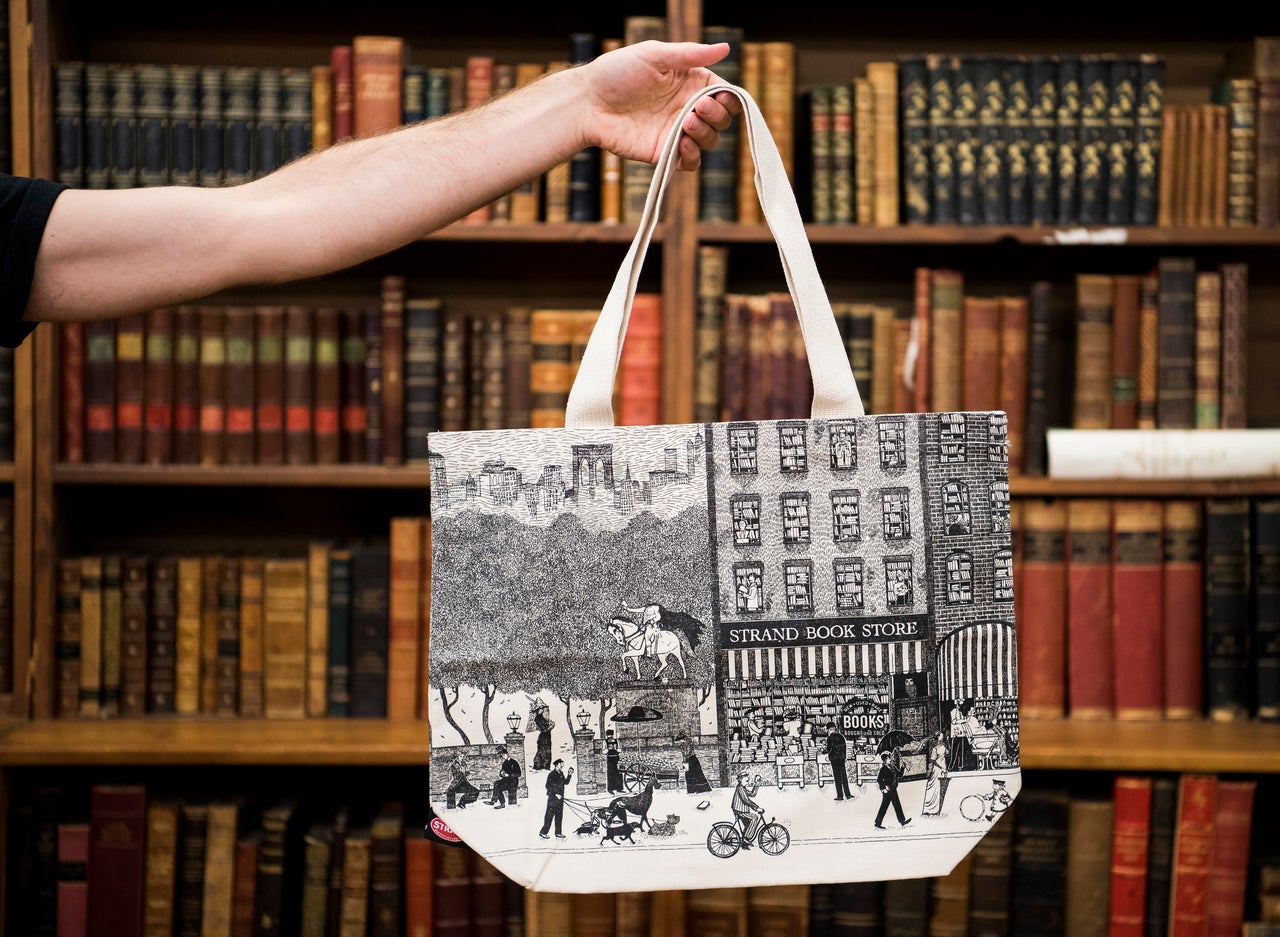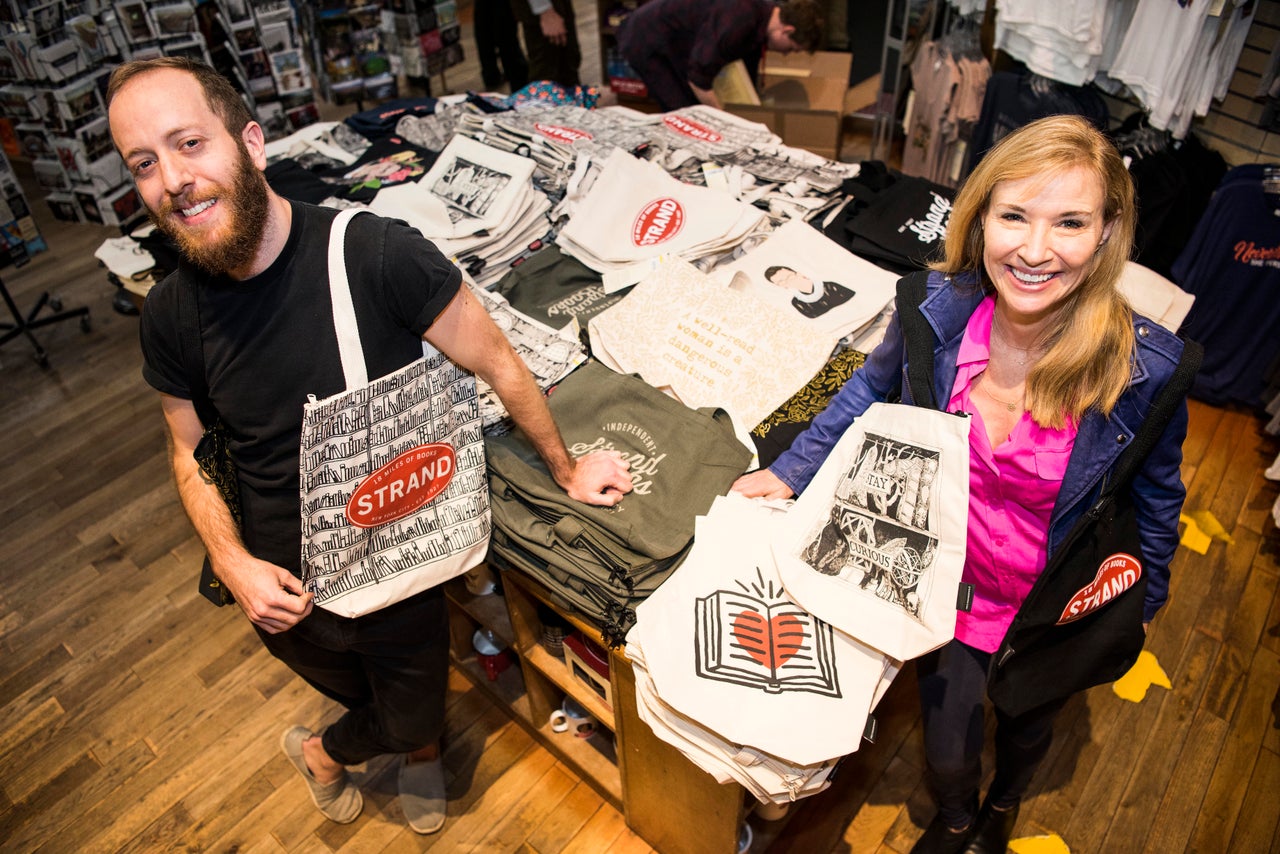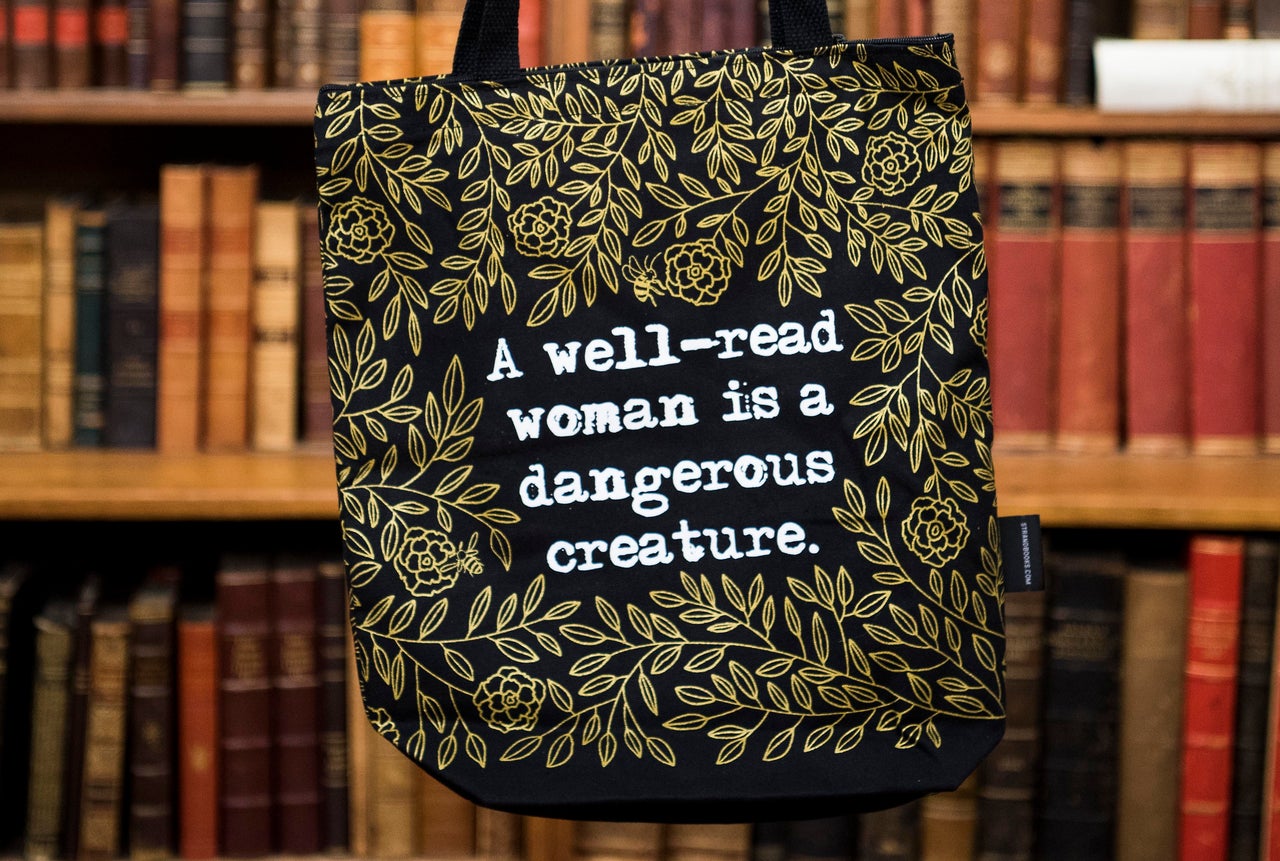Those who are familiar with New York’s Strand Book Store can likely recall its slogan: “18 miles of books.” It’s right there on the store’s ubiquitous red oval logo, seen citywide on tote bags carried by well-read locals and tourists alike.
But today, the 90-year-old Manhattan institution selling new and used books boasts closer to 23 miles of the printed word. (It’s measured, by the way, by book spines, exactly how they sit on the shelf.)
“I think 18 miles has such a nice ring to it,” senior designer Topher MacDonald said, recalling an old store awning that originally read “8 miles of books.” Eventually, “somebody tacked a 1 on top of it because [the store] had gotten too big,” he added.
However long the Strand’s stock is, the phrase is beautifully evocative. For a book lover catching sight of the slogan on a tote ambling around Central Park, it conjures images of never-ending stacks, more stories and curious plots than can be devoured in a lifetime.
Indeed, it’s the humble canvas tote, first sold at the Strand in the 1980s, that allows a bibliophile on-the-go to subtly transmit that image — and an image of themselves, too.
Current store co-owner Nancy Bass Wyden — the granddaughter of store founder Ben Bass — told HuffPost that the first iteration of the Strand tote was designed by a former longtime floor manager named Richard Devereaux. It had simple block letters, spelling out the store’s name, address and phone number on canvas.
That design persisted until the ’90s, when the bookstore’s now-famous red oval logo replaced it. The newer design, attributed to another floor manager’s girlfriend at the time, features the bookstore’s name in Strand Gothic (the store’s own font).
The initial tote was relatively small; it held only two or three books at a time. But it grew, and the designs became more varied, as the Strand began ramping up its merchandise section around 2012.
“My dad [Fred Bass] kind of resisted for many years. You know, ‘What are you doing to this place?! We should just have serious books!’” Bass Wyden said. He came around to the idea, she said, because it pleased customers.
“That was, and is, the most important thing to him,” she said.

The Strand has now offered over 100 original tote designs, ranging from political to whimsical. Walking around the store, you can spot canvas homages to Frida Kahlo and Michelle Obama laid out on tables, or get lost in an intricate hand-drawn city scene printed on a bag. There are totes with useful additions like zippers or small phone-sized pockets.
Books and tote bags go together naturally — one is an object to be carried, the other carries it. So it makes sense that Strand customers would gravitate toward the bookstore’s bags.
The appeal of a tote, however, goes beyond mere utility. On the surface, any Strand tote signals that its owner enjoys books. Perhaps the owner would also like to be seen supporting independent bookstores — an ever-more-political stance as Amazon and its ilk cast a long shadow over small businesses. Perhaps they have a connection to New York City; whether they live there, visit there, or know someone who visits there, they proudly flaunt the affiliation.
Once you start looking, it’s easy to spot a Strand tote or three on an average crowded subway. Their sheer ubiquity means the bags inevitably lose a factor or two of cool. In 2011, Vol. 1 Brooklyn riffed on the associations begotten by various literary totes, suggesting the typical Strand tote owner “probably [doesn’t] actually live in New York. Either that, or you’re a freshman at NYU.”
Still, for lit lovers who are unconcerned with urban cachet, there are plenty of options. Customers can buy a bag to communicate even more specific facts about themselves: I love cats. I am a feminist. Shakespeare is my personal superhero. I will not f**k someone who doesn’t own any books.
“We know that people that love books, love cats,” Bass Wyden said, reiterating a likely facet of many habitual readers’ personalities: They enjoy the indoors. “We always try to keep that in mind, you know: cozy, fireplace, coffee, tea.”
Hand-drawn designs — a trend seen popping up on book covers themselves ― have also proved popular, which Bass Wyden suggested was a result of the “backlash from technology” and living in an increasingly digital world.

Each tote mentions the Strand’s name in some way, usually showcasing that same red oval logo. (The Strand merchandizing team briefly tried a few other designs, replacing the “miles of books” slogan with the phrase “Where books are loved,” but ultimately went back to the original.)
Nearly 50 of the designs are credited to MacDonald, who began working out on the art department floor around five years ago. His handiwork ranges from delicate, multicolor illustrations of New Yorkers going about their day to an image of an extensively detailed library with ceiling-high bookshelves and cats around each turn.
MacDonald says the idea of a “weird, introvert fantasy world” inspired one of his latest designs: a dusty shelf stocked with a compass, a bell jar, a skull, books and other oddities, all presided over by a black cat. “Stay Curious,” it reads.
Ultimately, the designs come out of a collaborative process, with Bass Wyden and other staff members contributing ideas to a department called Studio Strand, which also consists of designers Greg Locke and Alison George and manager Meagan Henry. MacDonald, who hand-draws designs on a tablet, said that the collaboration can lead to little visual “Easter eggs” on the totes. MacDonald included his dog in a tableau of the city’s canine population. On another bag, the Japanese character for “book” takes the place of the “A” in “Strand” — another fun wink for those in the know.
At first glance, the store’s “Victorian Reader” seems to depict a straightforward scene of old-timey New York, with older building facades, horse-drawn carriages and people in the street with their noses in books.

Upon closer inspection, the attention to detail — creepy detail ― emerges. There’s a Headless Horseman statue and a violent barber inspired by Sweeney Todd. A carriage is being driven by a skeleton. Two identical twins ride eerily by on a tandem bicycle.
“I think [Bass Wyden was] just like, ‘Wouldn’t it be creepy if there were some abandoned shoes in the street?’” MacDonald recalled.
“It’s fun to create these opportunities for everyone. Like, what happens if you put a cobweb over here, or what happens if you put, like, a skull at the top of a building?” he continued. “Just making it as immersive as possible.”
Elsewhere in the design, a frustrated writer tosses his papers out the window. In another window, Bass Wyden’s grandfather peers out at the scene below. The design has been in the merchandise rotation for several years.
“It really is all of that detail that really makes it, you know, resonate for so long,” MacDonald added.

With an in-house design team, the bookstore can also adapt quickly to emerging trends and new catchphrases. When “Hamilton” was selling out nightly, a “Young, Scrappy and Hungry” bag popped up on shelves. When the coloring book craze seized bookstores around 2014, Strand answered with a tote featuring outlines of New York staples: a pigeon, the MetroCard.
The bookstore also offered “F**k 2016” pins and “Make America Read Again” totes: bold statements in a bold election year that allowed people to wear not just their love of reading, but their frustration, on their sleeves.
“I kept saying, ‘Don’t order too much! He’s not gonna be around!’” Bass Wyden said with a laugh, referring, of course, to now-President Donald Trump. The resistance is alive, well and for sale at the bookstore, where Ruth Bader Ginsburg totes lie on a table near others that read, “Nevertheless, She Persisted.”
A tote with the saying “A well-read woman is a dangerous creature” features what looks like a straightforward floral motif against black canvas, but upon further inspection, there are bees sprinkled throughout ― subtly underscoring the “dangerous creature” note. Other totes are collaborations with beloved artists like Art Spiegelman and Adrian Tomine.

Other designs have come from happenstance. Bass Wyden said a manager who collected autographs and drawings asked painter David Hockney to draw him a picture when he visited the store in the ’70s. Hockney drew a bag of books, which eventually became a tote.
“I thought that was funny, to put a tote on a tote,” Bass Wyden said.
For bookstore purists, the growth of the Strand’s in-store merchandise ― increasingly catering to an in-and-out kind of customer rather than one content to spend hours among the stacks ― might seem at odds with the store’s history as a haven for literature and those who love it. It’s understandable that seeing space occupied by bags advertising the store’s lengthy selection of books, instead of the books themselves, could chafe a certain kind of reader.
But if a bookstore must diversify its offerings to offset changing publishing trends or to reflect customer tastes, the creations tailored for bibliophiles at the Strand seem like a practical, and charming, way to meet in the middle. In a way, the many canvas bags on offer echo the varied customers drawn to the store in order to peruse its curated tables and outdoor carts — creative, singular, true New York originals.
